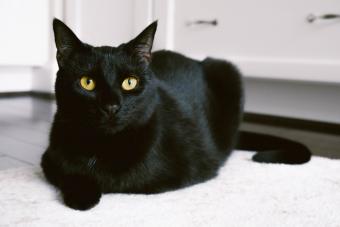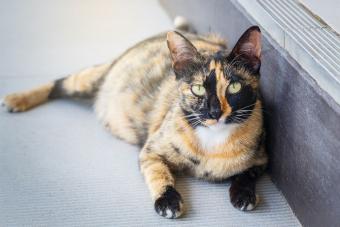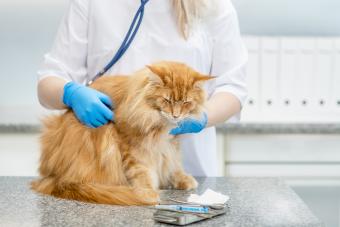Cat Eye Colors Ranked by Rarity

Cat eyes are legendary and beautiful. Fun fact: all kittens are born with blue eyes. As their eyes develop, the color will change to their permanent shade. And yes, some cats' eyes stay blue through adulthood. From the most common to the rarest cat eye colors and everything in between, we've got the 411 on your cat's eye color. Where do your cat's eyes rank in rarity?
7. Yellow

You've probably met many cats with yellow eyes because yellow is the most common cat eye color. Yellow feline eyes can range from pale yellow to a golden shade. While it's normal for a cat's iris to be yellow, if you notice the whites of the eyes appear a yellow shade, this could be jaundice and should be checked out by your vet right away.
Rarity: Very common
Cat breeds with yellow eyes: Chartreux, Bengal, Maine Coon, Burmese, American Shorthair, Bombay, Scottish Fold, British Shorthair, etc.
6. Hazel

Hazel eyes in cats are usually a combination of brown, green, and yellow. They can appear as a solid tawny color or have flecks of various colors throughout the iris. Hazel eye color in cats is pretty common and can be seen in several breeds as well as mixed-breed house cats.
Rarity: Common
Cat breeds with hazel eyes: Abyssinian, American Shorthair, Bengal, Norwegian Forest Cat, Scottish Fold, Cornish Rex, etc.
5. Green

Striking green eyes on a cat can take your breath away, but this eye color is more common than you think. Of all the cat eye colors, it's one of the least rare, but that doesn't make it any less beautiful. The shade can range from a pale green-gold to a deep emerald color.
Rarity: Somewhat common
Cat breeds with green eyes: Russian Blue, Norwegian Forest Cat, Bengal, Egyptian Mau, Abyssinian, American Shorthair, Havana Brown, etc.
4. Blue

Cats with blue eyes don't really have blue pigment in their eyes. This might sound like some type of riddle, but blue eye color is actually the absence of pigment within the iris. When the eye lacks pigment, the light refracted within the eye appears a blue shade to us. All kittens are born with blue eyes, but blue eyes in adult cats are relatively rare.
Rarity: Somewhat rare
Cat breeds with blue eyes: Siamese, Persian, Himalayan, Sphynx, Ojos Azules, Ragdoll, Balinese, Turkish Angora, Tonkinese, Snowshoe, etc.
3. Copper

Copper eyes are rare in cats. This is also the darkest eye color you will find in cats, though they can range from a light amber color to dark rust. A few cat breeds, like the Bombay and Persian, have copper listed as a desirable color within the breed standard, but other cats can also have these rare and stunning copper-colored eyes.
2. Heterochromia

Heterochromia is known as having "odd" eyes, where each of a cat's eyes is a unique color. Combinations can include one blue and one green eye, one hazel and one blue, etc. The gene that causes heterochromia is linked with a cat's coat color, so it's most common in cats with white fur. If you have an "odd-eyed" cat, know this is definitely rare!
Rarity: Rare
Cat breeds with heterochromia: Turkish Angora, Turkish Van, Khao Manee, Siamese, etc., but most common in white cat breeds.
1. Dichromia

The rarest eye color found in cats is dichromia, where one eye is two distinct colors. Often the iris looks like it's split right down the middle, with one-half blue, for example, and the other half hazel. Or there may be a random splotch of one color on the iris. This is a genetic phenomenon where each section has different levels of pigment, so they look different colors and are incredibly rare to see IRL.
Rarity: Very rare
Cat breeds with dichromia: Any, but most common in white cat breeds.
The Science Behind Cat Eye Color

Their breed can influence a cat's eye color, but it's really the amount of pigment in their iris and the way the light refracts that determines what color a cat's eyes will be. The iris is the colored portion of the eye, which contains cells called melanocytes that produce pigment. The more pigment within an eye, the darker a cat's eye color will look. Even though cats can't have dark brown or black eyes like humans, their eyes can appear a dark copper shade.
Predicting a Kitten’s Eye Color

Kittens grow into their permanent eye color. This is because the pigment-producing cells in their eyes don't develop until they're around 6 weeks old, so a kitten's eyes will look blue until the pigment develops. This transition typically finished by 12 weeks old. Even though it's nearly impossible to predict what color a kitten's eyes will become, it's fun to watch them grow into their adult shade.
Sign up for our newsletter featuring all the latest stories and products we love.
Eye Color and Deafness in White Cats

Deafness is actually directly linked with eye color in white cats. Research shows that as many as 85 percent of white cats with blue eyes are deaf in at least one ear. The incidence decreases with other eye colors: about 40 percent of white cats with heterochromia who have one blue eye are deaf, and 17 to 22 percent of white cats with other eye colors are hearing-impaired. Cats with other coat colors wouldn't be at the same risk unless their parents were both white cats.
Changing Eye Color in Cats

Can a cat's eye color change? No, it shouldn't. Once their melanocytes have developed, a kitten's eyes will settle into their true color by around 12 weeks of age. Changes to a cat's eye color after this age indicate there could be a problem with the eye, like uveitis or cataracts. Bring your cat to your veterinarian for an eye exam.
Cat Eye Color 101

Even if your cat's eye color isn't necessarily one of the rarest on the list, it could be rare for their breed or coat color. For example, it's unusual to find a pure white cat with hazel eyes or a black cat with heterochromia. Whatever their appearance, know your kitty is still one-of-a-kind.







